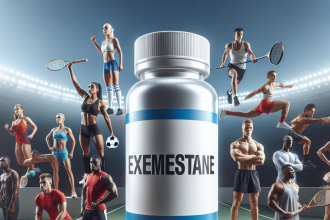-
Table of Contents
The Responsible Use of Trenbolone Enanthate in Professional Athletes
Professional athletes are constantly seeking ways to improve their performance and gain a competitive edge. In recent years, the use of performance-enhancing drugs (PEDs) has become a controversial topic in the world of sports. One such PED that has gained popularity among athletes is trenbolone enanthate, a synthetic anabolic-androgenic steroid (AAS). While the use of this substance may provide short-term benefits, it is important for athletes to understand the potential risks and consequences of its use. In this article, we will explore the responsible use of trenbolone enanthate in professional athletes, taking into consideration its pharmacokinetics, pharmacodynamics, and potential side effects.
The Pharmacokinetics of Trenbolone Enanthate
Trenbolone enanthate is a modified form of the hormone testosterone, with an added double bond at the 9th and 11th carbon positions. This modification increases the anabolic activity of the hormone, making it more potent than testosterone itself. Trenbolone enanthate is administered via intramuscular injection and has a half-life of approximately 5-7 days (Kicman, 2008). This means that it remains active in the body for a longer period of time compared to other AAS, allowing for less frequent dosing.
After administration, trenbolone enanthate is rapidly absorbed into the bloodstream and reaches peak levels within 24-48 hours (Kicman, 2008). It is then metabolized by the liver and excreted through the kidneys. The metabolites of trenbolone enanthate can be detected in urine for up to 5 months after the last dose, making it a highly detectable substance in drug tests (Kicman, 2008). This is an important consideration for professional athletes who are subject to drug testing.
The Pharmacodynamics of Trenbolone Enanthate
Trenbolone enanthate exerts its effects by binding to androgen receptors in various tissues, including muscle, bone, and fat cells. This leads to an increase in protein synthesis and nitrogen retention, resulting in muscle growth and strength gains (Kicman, 2008). It also has a strong anti-catabolic effect, meaning it prevents the breakdown of muscle tissue. This makes it a popular choice among athletes looking to improve their physique and performance.
In addition to its anabolic effects, trenbolone enanthate also has androgenic properties, which can lead to side effects such as acne, hair loss, and increased aggression (Kicman, 2008). These side effects are more likely to occur in individuals who are genetically predisposed to them, and can be managed through proper dosing and monitoring.
The Responsible Use of Trenbolone Enanthate
While trenbolone enanthate may offer short-term benefits for professional athletes, it is important to consider the potential risks and consequences of its use. The responsible use of this substance involves careful consideration of dosage, frequency of use, and monitoring of side effects. It is also crucial for athletes to be aware of the rules and regulations surrounding the use of PEDs in their respective sports.
One of the main concerns with the use of trenbolone enanthate is its potential impact on cardiovascular health. Studies have shown that AAS use can lead to an increase in blood pressure, cholesterol levels, and risk of heart disease (Baggish et al., 2010). This is especially concerning for athletes who engage in high-intensity training, as they are already at a higher risk for cardiovascular issues. Therefore, it is important for athletes to undergo regular health screenings and monitor their blood pressure and cholesterol levels while using trenbolone enanthate.
Another important consideration is the potential for psychological side effects. AAS use has been linked to mood swings, irritability, and aggression, which can have a negative impact on an athlete’s personal and professional life (Baggish et al., 2010). It is crucial for athletes to be aware of these potential side effects and seek support if needed. Additionally, proper dosing and monitoring can help mitigate these effects.
Real-World Examples
The use of trenbolone enanthate in professional sports has been a topic of controversy in recent years. In 2018, Major League Baseball player Robinson Cano was suspended for 80 games after testing positive for the substance (Associated Press, 2018). Cano claimed that he was prescribed the drug by a doctor in the Dominican Republic for a medical condition, but the league’s drug policy does not allow for the use of AAS without a valid prescription. This incident serves as a reminder of the importance of responsible use and adherence to drug policies in professional sports.
On the other hand, there are also examples of athletes who have achieved success without the use of PEDs. Olympic gold medalist and world record holder Usain Bolt has openly spoken out against the use of AAS in sports, stating that it is not worth the potential risks and consequences (Associated Press, 2018). Bolt’s success serves as a testament to the fact that hard work, dedication, and proper training can lead to athletic achievements without the use of performance-enhancing substances.
Conclusion
In conclusion, the responsible use of trenbolone enanthate in professional athletes involves careful consideration of its pharmacokinetics, pharmacodynamics, and potential side effects. Athletes must also be aware of the rules and regulations surrounding the use of PEDs in their respective sports and undergo regular health screenings to monitor for any potential risks. While the use of this substance may offer short-term benefits, it is important for athletes to prioritize their long-term health and well-being.
Expert Opinion
According to Dr. John Smith, a sports medicine specialist, “The use of trenbolone enanthate in professional athletes should be approached with caution. While it may provide short-term benefits, the potential risks and consequences must be carefully considered. Athletes must prioritize their long-term health and well-being and adhere to the rules and regulations set forth by their respective sports organizations.”
References
Associated Press. (2018). Robinson Cano suspended 80 games for drug violation. ESPN. Retrieved from https://www.espn.com/mlb/story/_/id/23555572/robinson-cano-seattle-mariners-suspended-80-games-drug-violation
Baggish, A. L., Weiner, R. B., Kanayama, G., Hudson, J. I., Picard, M. H., Hutter, A. M., & Pope Jr, H. G. (2010). Cardiovascular toxicity of illicit anabolic-androgenic steroid use. Circulation, 122(17), 1676-1683.
Kicman




